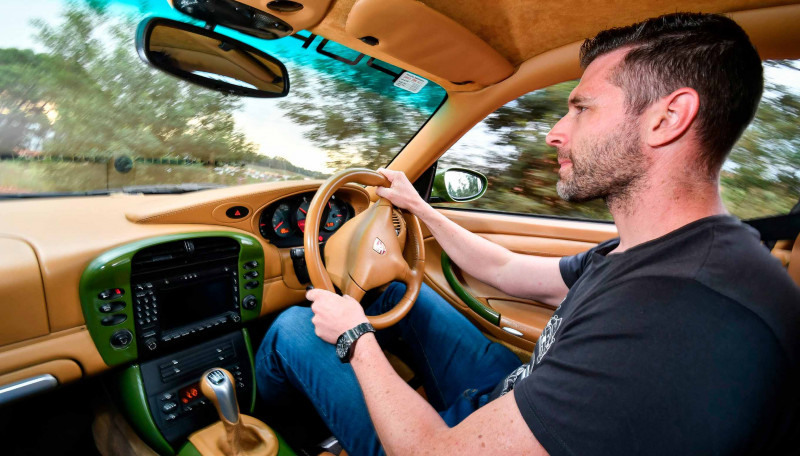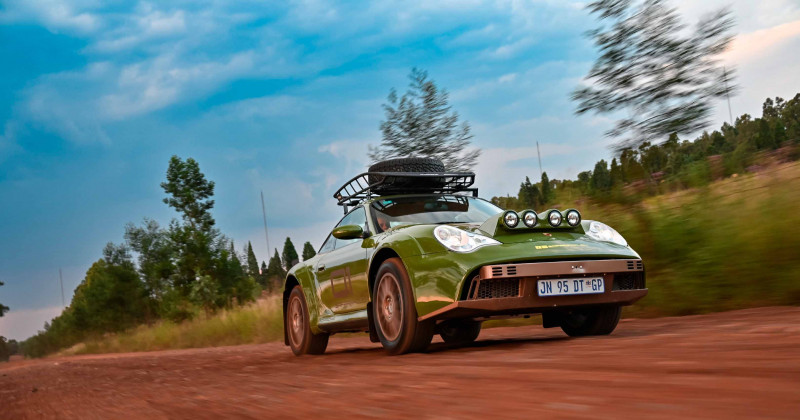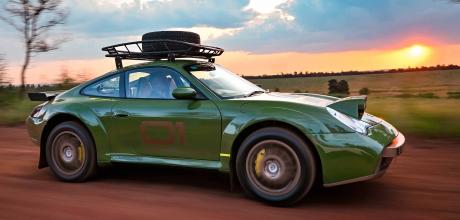2003 Porsche 911 Carrera 4S ‘Safari 996.2
In recent years we’ve seen various 911s in custom safari trim. However, none of these were ever based on the 996. That changed when one South African enthusiast decided to build his own… 996 Written by Wilhelm Lutjeharms. Photography by Rob Till.
2003 Porsche 911 Carrera 4S ‘Safari 996.2
Former works driver Mike Rockenfeller looks back on his experiences in competition with the 996
Listening to an enthusiast’s path to Porsche always makes for a fascinating experience. Every story is special, but the most intriguing accounts from our point of view tend to come from those determined drivers who, at some point, decide to build their own car. Johan de Bruyn is no different. “I’ve always been a car guy, right from when I was a boy – the love for Porsche came a little later in my life. When I finally had some money to spend on a sports car, I bought a 997 Carrera S. I then realised I’ll never look to a BMW or Mercedes-Benz to give me my thrills,” he says.

Johan became a member of the Porsche Club early on in Porsche ownership, then bought a couple of GT3s and RS products, and subsequently got sucked into what Porsche offers and represents. He also raced with a classic 911 in the local Historics Class and topped it all off with a 997 Cup car.
“Apply enough throttle and the rear will easily step out on gravel surfaces”
During his racing excursions he met Phillip Visser. The latter has a long career as a race car builder and race technician, for privateers as well as OEMs like Volkswagen, and he worked on several of Johan’s cars. Johan explains when and how the idea originated to build this car. “It was during 2020 when I had two knee replacements that I had some time to read, and I realised everyone is doing resto-mods, but no one is doing anything with the 996. Enthusiasts have been looking down on the 996 for a very long time, but personally I like the lights and overall design of the car. I started doing some research on the internet. You can buy online nearly any aftermarket off-road, rally-inspired part for most Porsche 911s. However, when I searched for parts for a 996, I discovered there was nothing.

“We searched some more and realised that no one has been through the design and development processes to build a Safari 996. We found one car in Russia, but that was more for racing and wasn’t really road friendly. Then we decided to buy a 996 and develop it into a Safari car. We first had to sit down and decide what would be the purpose of the car. We wanted the practicalities of a daily driver, it wasn’t to be too loud, it should have a unique design, and then most importantly, you should be able to tackle gravel roads with your friends in their Ford Raptors. It should have improved suspension, but the airbags, air conditioning and radio should be functional, the car thus being useable and practical.

“We decided on a Carrera 4S because the wider body, improved power delivery and improved brakes appealed to us.”
Such a project obviously has its difficulties and Phillip eagerly shares these. “One of the first challenges was to fit the larger wheel and tyre combination, as the radiators and suspension cross members were in the way. Then, the front track is too narrow compared to that of the rear track for an off-road car. Here you want the rear tyres to follow in the tracks of the fronts.
“So, we looked at the amount of space we had, what and how we can shift things around and what size tyres we can fit. We spoke to Reiger regarding the shock absorbers, discussing how much wheel travel we would like and how much space we have to work with. The result is that we now have close to 200mm of wheel travel on each corner and an enormous 280mm of ground clearance.

“The control arms at the front are 120mm wider in total and at the rear around 60mm. The top mounts for the MacPherson struts I had to move outwards and the drive shafts are longer. The engine is mostly standard although we replaced the IMS bearing, the catalytic converters have been removed and it was fitted with a set of performance headers. Local exhaust specialist Van der Linde Systems built the exhaust as a custom project. It’s a beautiful system, but unfortunately hidden behind the custom rear bumper.
“The entire bottom of the car has been covered. At the front by a 3mm thick steel bash plate, and from the middle of the car rearwards a polyurethane-coated 5mm aluminium plate does duty. This is of course to protect all the paraphernalia underneath the car when taken off-road.”
Staying at the rear, a limited slip differential was fitted to put the torque down more effectively. The unique wheel arch extensions and rear wing are made from glass fibre, finished by hand after moulding. Parts like the metal bumper extensions were designed using CAD software, while other parts were 3D printed. Suspension parts, like the lower control arms, were made from 7075 aluminium, CNC machined and hot anodised thereafter.
Johan continues: “Phillip lives 150 miles from me, so the design and build process took some time. Hundreds of pictures were shared backwards and forwards over the past year-and-a-half to make sure we were on the same page.”
The seats are light and unique, because they’re made from carbon-fibre, and have an interesting story behind them. Phillip explains: “At some stage in my working life I managed to get a hold of these two Mercedes-Benz SLR McLaren carbon-fibre shells. I’ve had these seat bases for probably around 15 years knowing that somewhere along the line I’d find a use for them. When we started this project, I decided that these seats would be a perfect fit. Cushions were made for the bases and the seat backs were painted in the same colour as the car.” Johan and Phillip have also made moulds from the seats, so if they want to replicate them in the future they can.
A set of four IPF spotlights have been fitted on the luggage lid. Phillip designed and made the mould for the cover himself. It is arguably, along with the Thule Canyon XT roof rack carrying a spare wheel, the main exterior features that clearly show off this 996’s true nature. As with some of the suspension parts, Phillip had to design the brackets to make the roof rack fit. The car is already generating interest, because a second car is currently being built that might be for sale.
From the day Phillip opened his toolbox to start stripping the 996 Carrera 4S until final project completion was around 18 months, with designing and discussion happening on the trot all along during this time. Needless to say, the second car will most likely take much less time to build.
Parked outside Pretoria on a dark gravel road sitting on raised suspension, off-road tyres and with solid metal bumpers, this particular 996 oozes intent, much more so than the arguably anodyne look of a standard 996.
As I get into the car, some tasteful exterior colour coordinating touches are immediately obvious. Parts around the infotainment system and ventilation controls, as well as the transmission tunnel and handbrake lever, have been painted the same as the car’s exterior hue; the latter being a slight variation on Porsche’s Olive green.
Today, on this Highveld gravel road with tall grass borders, the car fits right in. It may as well be competing in the East African Safari. The seats feel solid and sturdy – race car-like – and I initially think there may not be sufficient padding. But this isn’t the case and I settle easily. I reckon even larger drivers will get comfy without much trouble. The rest of the cabin is pure 996 with the carpet trim on the lower areas of the doors still in place, as well as the small seats in the back. With the fixed front seats (although still fitted to their rails), the rear seats are best used as luggage space.
Even though the car is two decades old, the rest of the cabin is in a relatively good condition. It provides the straightforward instrumentation and button layout of the 996 generation. The view over the bonnet is unlike any other 911 I’ve driven, however. The rear of the spotlight cover is clearly visible and it immediately makes you think you’re Björn Waldegård. Although you might sit higher off the ground thanks to the raised body, the seat is still close to the floor, so the driving position remains very much that of a sports car.
Driving the car at speed on gravel surfaces varying from smooth to heavily and irregularly pockmarked, the pliancy and breadth of ability provided by the suspension and tyre combination is impressive. It requires a bit of a mind shift to adapt to the fact that you don’t need to swerve for the slightest pothole or bump in the road.
Even though the Safari weighs more than the standard car, its 320bhp on offer is more than enough to make things exciting on a gravel road. It again confirms that you need less power on a gravel road than on tarmac to have fun. Even though the car’s all-wheel drive, and still supplying a small percentage of the torque to the front axle, when you apply enough throttle the rear will easily step out on gravel surfaces, still giving you that distinctive rear-wheel drive experience.
The car feels confident in its new role and there’s nothing actually stopping you from tackling the gravel roads strewn throughout Southern Africa for a very pleasant multiple-week road trip – once you’ve loaded a few tools and materials that you may not find in the back woods.
Back on the road the capabilities of a 911 are immediately apparent. The car still pulls strongly right around the dial to just over 7,000rpm, while the slick-shifting gearbox is line with the shift quality that I’ve experienced on other 996s I’ve driven, including GT3s.
It’s only during heavy cornering and under braking that you realise there’s more body roll and dipping from the body and suspension. It’s to be expected, of course, but overall the true 911 sports car driving experience is still very evident here.
As the owner jokingly mentions, the aim of this Safari is to be able to tow other 4x4s out of tricky situations when they get stuck, while still offering that typical 911 experience. In my eyes, those two boxes have been firmly ticked.
ABOVE LEFT Chassis fettling includes wider control arms, relocated top mounts, and long-travel Reiger coilovers
ABOVE Even with the off-road trappings such as the bonnet-mounted spotlights, the 996 Safari still feels as though you’re sitting in a sports car
LEFT Johan and Phillip worked to give the car a decent amount of ground clearance – 280mm, no less!
Model 996 Carrera 4S
Year 2003
Engine
- Capacity 3,596cc
- Compression Ratio 11.3:1
- Maximum power 320bhp at 6,800rpm
- Maximum torque 370Nm at 4,250rpm
- Transmission Six-speed manual
Suspension
- Front Independent, MacPherson strut, coil springs
- Rear Independent, multilink, coil springs
Wheels & tyres
- Front & Rear 8x18-inch OZ Racing wheels all round; 235/55 R18 tyres
Dimensions
- Length 4,480mm
- Width 1,949mm
- Weight 1,555kg
Performance
- 0-62mph 5.6 seconds
- Top speed 171mph
ABOVE The interior trim is the same colour as the exterior: a slight variation on Porsche’s Olive green
BELOW Essential for all off-road trips, a spare wheel is stored on the Thule Canyon XT roof rack.
History of the Porsche 911 in rallying
Porsche has a long-standing association with competitive racing. Indeed, the company was entering events shortly after it was founded. Only three months after production started of the 911 2.0-litre, a car was entered into its first international rally: Herbert Linge and Peter Falk took part in the 1965 Monte Carlo Rally, with Vic Elford winning the race in 1968. in 1968 Porsche also prepared three 911s for customers to take part in the 10,000-mile London–Sydney Marathon. Two of the cars finished, while the third dropped out in Afghanistan owing to brake problems.
Success on dirt continued with Björn Waldegård and Lars Helmer winning the Swedish Rally (1969) as well as Austria’s Alpine Rally (1970). Then in 1974, three Carrera 2.7 ‘Safaris’ were entered in the East African Safari. Based on the Carrera RS, Björn Waldegård and Hans Thorzelius brought one of these home in second place. In 1978 two 911 SC 3.0 Safaris were entered by the factory in the 26th Safari Rally Kenya.
Another name that’s synonymous with Porsche and rallying is Walter Röhrl. He signed with Porsche in 1981 and entered the San Remo Rally with a 911 SC, but sadly on this excursion a half shaft broke. Porsche’s success with the 959 in the 1986 Paris–Dakar Rally is well documented, but the lead-up to that event came with the success of René Metge behind the wheel of a 911 Carrera 4x4 (also called the 953) with a massive 27cm of ground clearance. This laid the foundation for the upcoming rally success of the 959.


